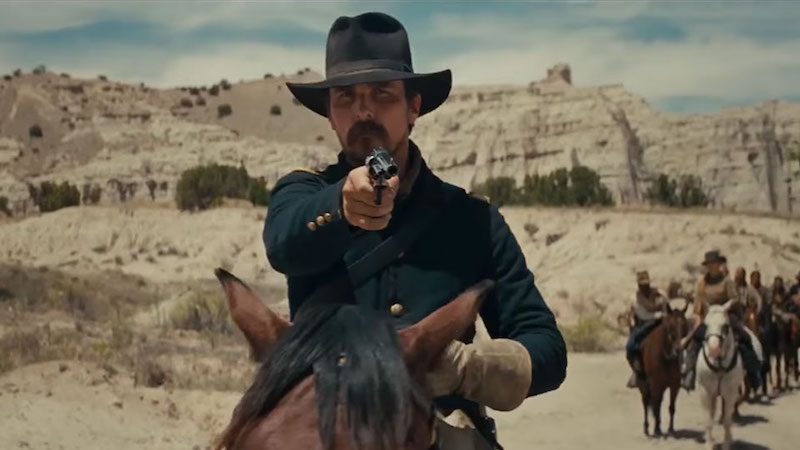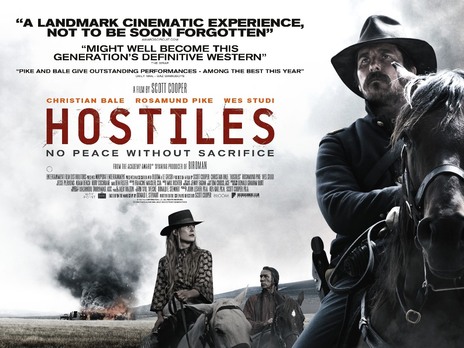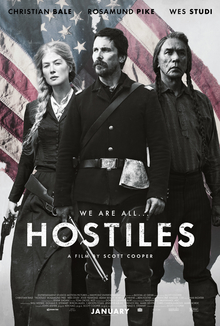Hostiles – no peace with patriarchy
- 29 December 2017
- Posted by: Michael H Hallett
- Category: Arts , Patriarchy ,

The advertising hoardings of the London Underground are currently filled with posters for a new film, Hostiles. Scheduled for release in January 2018, Hostiles is described as “a landmark cinematic experience” that “might well become this generation’s definitive western.” These heady advance reviews suggest that Hostiles should be near the top of your cinema go-to list for the New Year.

The film’s tag line suggests otherwise: “no peace without sacrifice.” A film’s tag line is the one-liner that appears on the poster. (It shouldn’t be confused with the log line, a one-sentence précis that answers the following questions: Who is the protagonist? What challenge do they face? How do they face it?)
A tag line is a thematic summary of a film. “No peace without sacrifice” indicates that Hostiles expounds on Thomas Jefferson’s quote, “The tree of liberty must be refreshed from time to time with the blood of patriots and tyrants.” It seems a reasonable theme for Hostiles, which is set in 1892 at the tail end of the so-called Indian Wars.
Text and subtext
There’s only one problem. While the text of Hostiles may be set during the Old West, its subtext is set in the present day.
The key to understanding the tag line of Hostiles lies in a book published 20 years ago. In Story, legendary Hollywood screenwriting guru Robert McKee declares that, “the only legitimate excuse to set a film in the past and thereby add untold millions to the budget, is anachronism—to use the past as a clear glass through which you show us the present.”
What “no peace without sacrifice” shows us in the present is that the American deep state—via its increasingly discredited mouthpiece, Hollywood—wants you to accept that no peace is possible without the shedding of blood
What “no peace without sacrifice” shows us in the present is that the American deep state—via its increasingly discredited mouthpiece, Hollywood—wants you to accept that no peace is possible without the shedding of blood, both yours and of your enemies.
Am I suggesting that the makers of Hostiles deliberately set out to broadcast this subversive bit of propaganda and emotional fear-mongering? Not necessarily. Anyone who has unconsciously bought into this message will automatically and equally unconsciously replicate it. The producer who signed off on the tag line either believed it—or at least believed in its box office power.
Perpetual war
Setting aside the contradiction in terms that peace requires bloodletting, what does this tag line tell us? Prepare for a world of perpetual war. What it doesn’t say is that patriarchies require enemies in order to function. If no legitimate enemies exist the deep state must manufacture them in order to remain relevant. This is George W. Bush territory: without a ‘them’ there is only ‘us’—and peace.

A second poster with a different tag line reinforces the assertion that Hostiles is a present-day positioning piece. This one reads: “We are all hostiles.” This poster is pure patriarchy. An armed, uniformed white male (Christian Bale) occupies the foreground. Behind him stand a white female (Rosamund Pike)—also armed, a significant piece of symbolism—and a Native American male (Wes Studi). The pecking order (also observed in the film’s poster) is clear. An American flag fills the background, indicating what is supposedly being protected.
A still released to market the film further supports this analysis. Bale points his pistol directly at the audience, breaking the fourth wall. Read in conjunction with the “We are all hostiles” tag line, its meaning is clear. You are in danger. Hand over your rights, your resources, and—if necessary—your life, and all will be well. The question here is, who are the real hostiles?
Images: Hostiles (Entertainment Studios Motion Pictures, 2017)
